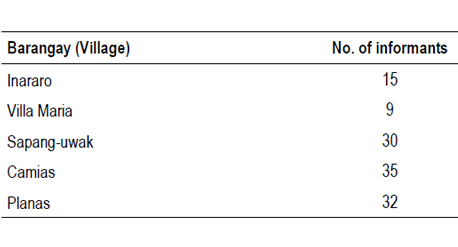VOLUME 7 NUMBER 1 (January to June 2014)

Philipp. Sci. Lett. 2014 7 (1) 179-186
available online: May 24, 2014
*Corresponding author
Email Address: jaobico@up.edu.ph
Received: January 15, 2014
Revised: March 31, 2014
Accepted: April 2, 2014
ARTICLE
A survey of plants used as repellents against hematophagous insects by the Ayta people of Porac, Pampanga province, Philippines
Jasper John A. Obico* and Elena M. Ragragio
Department of Biology, College of Arts and Sciences, University of the Philippines
Manila, Padre Faura St., Ermita 1000, Manila
Most popular plants with insect-repellent activity are non-native to the Philippines and can pose an ecological threat when propagated for its utility. Indigenous knowledge provides a wealth of information on native plants with such potential application. To document the insect-repellent plants used by the Ayta people from Porac, Pampanga, Philippines, 121 informants from five villages aged between 20-60 years old were interviewed. Data were analyzed using the use-value (UV) and informant consensus factor (FIC). The survey resulted in a list of 54 species of plants classified into 49 genera and 26 families. The Family Fabaceae contains the most number of species with insect-repellent activity. The most important plants used as insect repellent based on their UVs are mostly exotic plants and include 7 species: (1) Leucaena leucocephala (Lam.) de Wit, (2) Gliricidia sepium (Jacq.) Walp., (3) Eucalyptus sp., (4) Gmelina arborea Roxb., (5) Blumea balsamifera (L.), DC., (6) Azadirachta indica A. Juss., and (7) Phyllodium pulchellum (L.) Desv. The FIC value (0.78) indicates that the Ayta agree in their selection of plants. Most of the plant parts used are the leaves and stems, which are dried and then burned. The smoke is said to drive away the insects. The use of Leucaena leucocephala, Gliricidia sepium, Eucalyptus sp., and Azadirachta indica is supported by published works. A new record on insect-repellent activity is found in the exotic Gmelina arborea and two native plants, Blumea balsamifera and Phyllodium pulchellum. The present study may provide a baseline for phytochemical screening for insect-repellent compounds. It also serves as an important ethnobotanical documentation of the Ayta community whose culture is slowly being eroded by acculturation.
© 2025 SciEnggJ
Philippine-American Academy of Science and Engineering